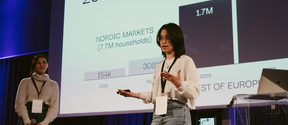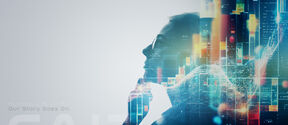Dances with waves: breakthrough in moving small objects using acoustics
Researchers move multiple objects simultaneously and independently on a plate by playing carefully chosen musical notes. Video: Quan Zhou, Kourosh Latifi
Researchers of Aalto University have made a breakthrough in controlling the motion of multiple objects on a vibrating plate with a single acoustic source. By playing carefully constructed melodies, the scientists can simultaneously and independently move multiple objects on the plate towards desired targets. This has enabled scientists, for instance, writing words consisting of separate letters with loose metal pieces on the plate by playing a melody.
Already in 1878, the first studies of sand moving on a vibrating plate were done by Ernst Chladni, known as the father of acoustics. Chladni discovered that when a plate is vibrating at a frequency, objects move towards a few positions, called the nodal lines, specific to that frequency. Since then, the prevailing view has been that the particle motion is random on the plate before they reached the nodal line. “We have shown that the motion is also predictable away from the nodal lines. Now that the object does not have to be at a nodal line, we have much more freedom in controlling its motion and have achieved independent control of up to six objects simultaneously using just one single actuator. We are very excited about the results, because this probably is a new world record of how many independent motions can be controlled by a single acoustic actuator,” says Professor Quan Zhou.
We are very excited about the results, because this probably is a new world record of how many independent motions can be controlled by a single acoustic actuator.
The objects to be controlled have been placed on top of a manipulation plate, and imaged by a tracking camera. Based on the detected positions, the computer goes through a list of music notes to find a note that is most likely to move the objects towards the desired directions. After playing the note, the new positions of the objects are detected, and the control cycle is restarted. This cycle is repeated until the objects have reached their desired target locations. The notes played during the control cycles form a sequence, a bit like music.
Image: Quan Zhou
The new method has been applied to manipulate a wide range of miniature objects including electronic components, water droplets, plant seeds, candy balls and metal parts. “Some of the practical applications we foresee include conveying and sorting microelectronic chips, delivering drug-loaded particles for pharmaceutical applications or handling small liquid volumes for lab on chips,” says Zhou. “Also, the basic idea should be transferrable to other kinds of systems with vibration phenomena. For example, it should be possible to use waves and ripples to control floating objects in a pond using our technique.”
The article has today been published on Nature Communications. DOI: 10.1038/ncomms12764
Contact details:
Professor Quan Zhou
Aalto University (Finland)
Tel. +358 40 855 0311
quan.zhou@aalto.fi
Read more news

Aalto University to host INNOVA Europe 2026 Grand Final in Espoo
Aalto University will host the INNOVA Europe 2026 Grand Final in Espoo, bringing together leading student-led startups from European universities.
Finnish AI Region Secures Second Term with Top Marks from EU
Finnish AI Region (FAIR) EDIH has been selected to continue operations for a second term with excellent ratings. European Union continuation funding enables service expansion from the beginning of 2026. Aalto University is one of 10 partners in FAIR.
Business & economics and computer science ranked in top 100 globally
The Times Higher Education ranking measures universities with 18 indicators, including international research and citations






